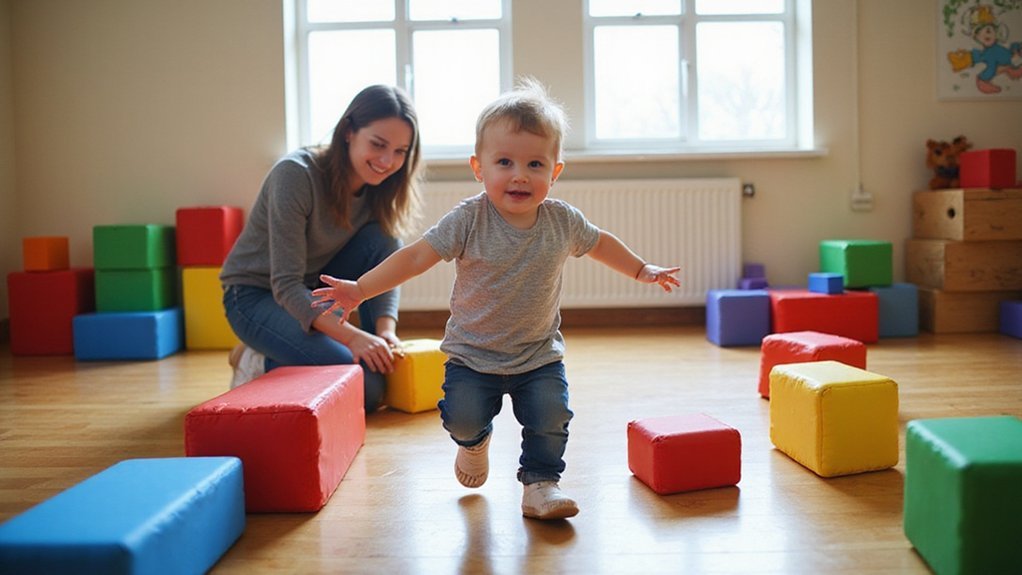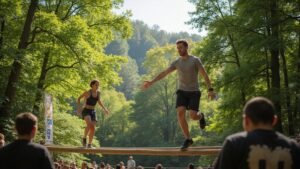When you’re supporting a child with Down syndrome, understanding their unique motor skill challenges becomes essential. You’ll find that specialized play equipment isn’t just about fun—it’s a strategic developmental tool. These adaptive resources can transform physical limitations into opportunities for growth, helping children build strength, coordination, and confidence. But how exactly can the right playground environment reveal potential and support your child’s motor skill journey? The answers might surprise you.
Key Takeaways
- Trampolines and in-ground bouncing surfaces provide critical balance training, coordination enhancement, and muscle tone development for children with Down syndrome.
- Climbing structures with varied textures and heights offer safe opportunities to build strength, improve gross motor skills, and boost physical confidence.
- Sensory-integrated play equipment like musical panels, tactile walls, and obstacle courses support multisensory motor skill learning and developmental progression.
- Adaptive swings and supportive playground features accommodate different muscle tone levels, enabling children to practice standing, movement, and spatial awareness.
- Interactive play stations with graduated difficulty levels allow personalized motor skill development, promoting independence and progressive physical milestone achievement.
Understanding Motor Skill Challenges in Down Syndrome
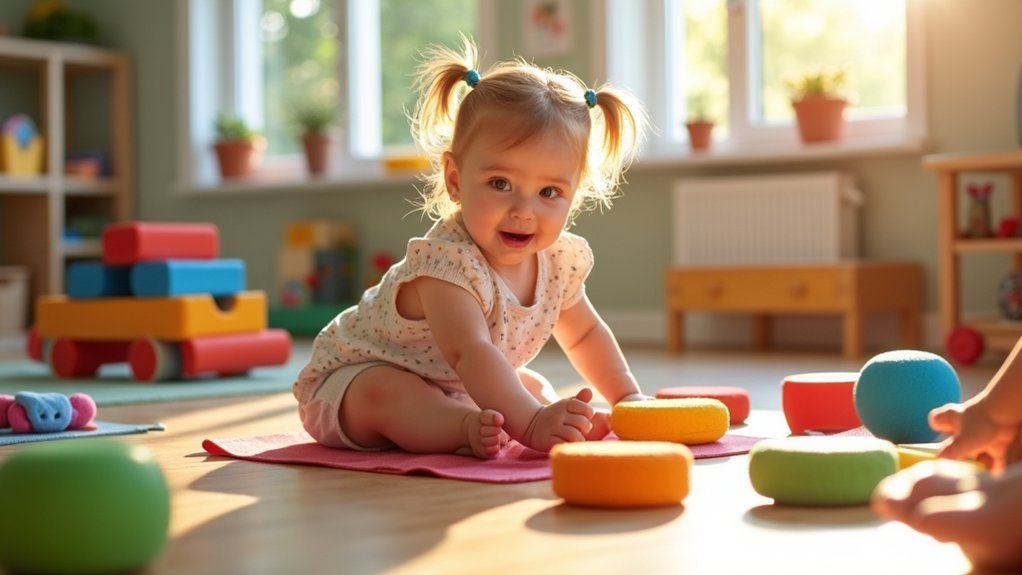
While motor skill development can be challenging for children with Down syndrome, understanding the underlying factors is essential for effective intervention. Low muscle tone and hypotonia greatly impact gross motor skills, creating unique obstacles in coordination and strength acquisition. These physical challenges mean children with Down syndrome often require more focused, targeted play-based activities to support skill development.
Supportive play equipment and balance exercises can help compensate for decreased muscle control and hypermobility. By creating engaging environments that encourage safe exploration, you’ll help these children progressively build motor skills. Strategic interventions focusing on repetitive movements and adaptive techniques can transform potential limitations into opportunities for growth, enabling children with Down syndrome to develop greater physical independence and confidence.
Playground Design for Inclusive Play Experiences
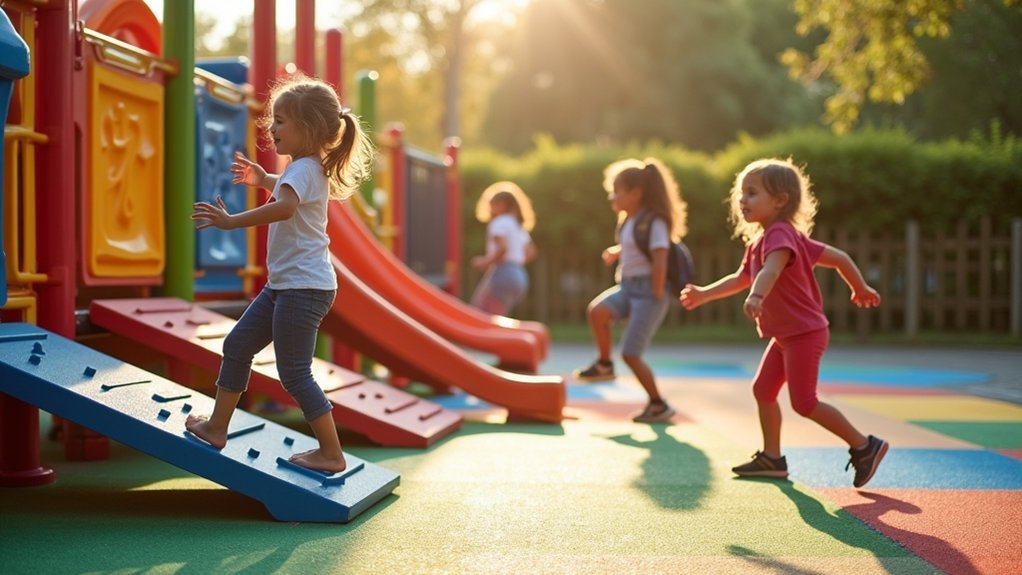
Because inclusive design transforms playgrounds into dynamic learning environments, creating spaces that welcome children of all abilities becomes an essential goal for educators and community planners. When designing for children with Down syndrome, focus on motor skill development through accessible equipment that promotes sensory play and social interaction. Thoughtfully selected playground structures like climbing frames, swings, and slides can accommodate varying developmental needs while encouraging independent exploration. Incorporate sensory panels with tactile and auditory elements, use contrasting colors, and create zones with moving components to maximize engagement. These play-based experiences help children practice turn-taking, build self-confidence, and develop vital motor skills. By prioritizing inclusive playgrounds, you’ll create welcoming spaces where every child can learn, play, and grow together.
Essential Equipment for Gross Motor Development

Since developing gross motor skills is fundamental for children with Down syndrome, strategic equipment selection can dramatically transform their physical capabilities. Play-based equipment like trampolines, swings, and obstacle courses provides essential opportunities for enhancing coordination, strength, and sensory integration. By incorporating climbing structures, ball pits, and oversized sporting equipment, you’ll support children in practicing diverse movements that challenge muscle groups and promote independence.
These targeted tools aren’t just recreational; they’re developmental interventions designed to facilitate vital physical milestones. Each piece of equipment offers unique challenges that encourage climbing, descending, throwing, and jumping—complex motor skills essential for building confidence and physical competence. Through thoughtful, engaging play experiences, children with Down syndrome can progressively develop the gross motor skills necessary for social interaction and personal growth.
Sensory Integration Through Play Structures
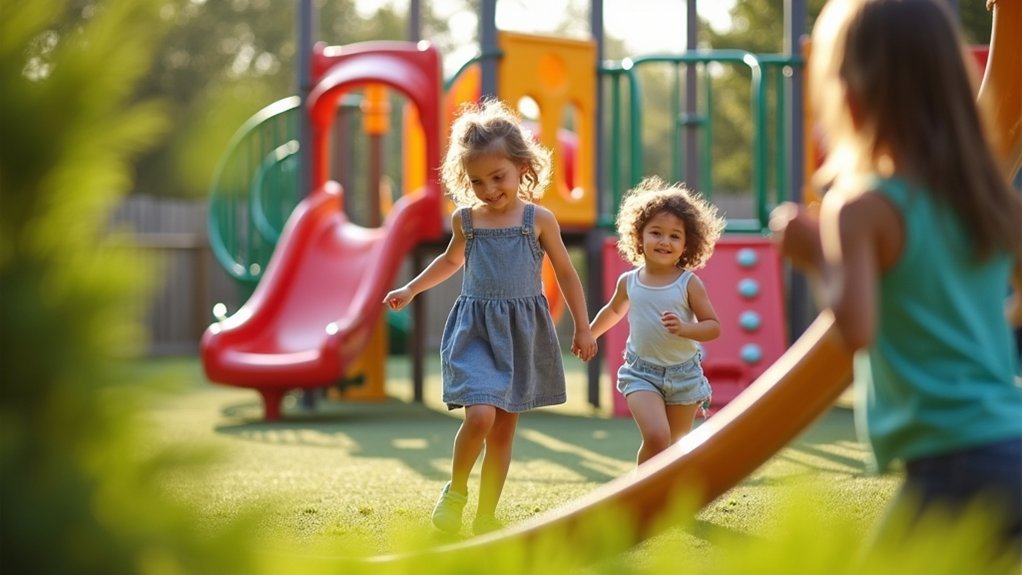
Sensory integration plays a critical role in motor skill development for children with Down syndrome, particularly through strategically designed play structures. These specialized environments offer multisensory experiences that support thorough developmental needs.
- Climbing walls with varied textures stimulate tactile and visual processing
- Musical elements encourage auditory engagement and communication skills
- In-ground trampolines and swings provide balance and coordination training
- Observation areas enable comfortable social interaction and sensory regulation
Play structures become powerful tools for improving gross motor skills when they incorporate diverse sensory experiences. By intentionally designing spaces that challenge and support children with Down syndrome, therapists and educators can create inclusive environments that promote self-regulation, motor skill development, and social interaction. The strategic use of sensory play structures transforms playground equipment into therapeutic intervention spaces.
Building Strength and Coordination Strategies
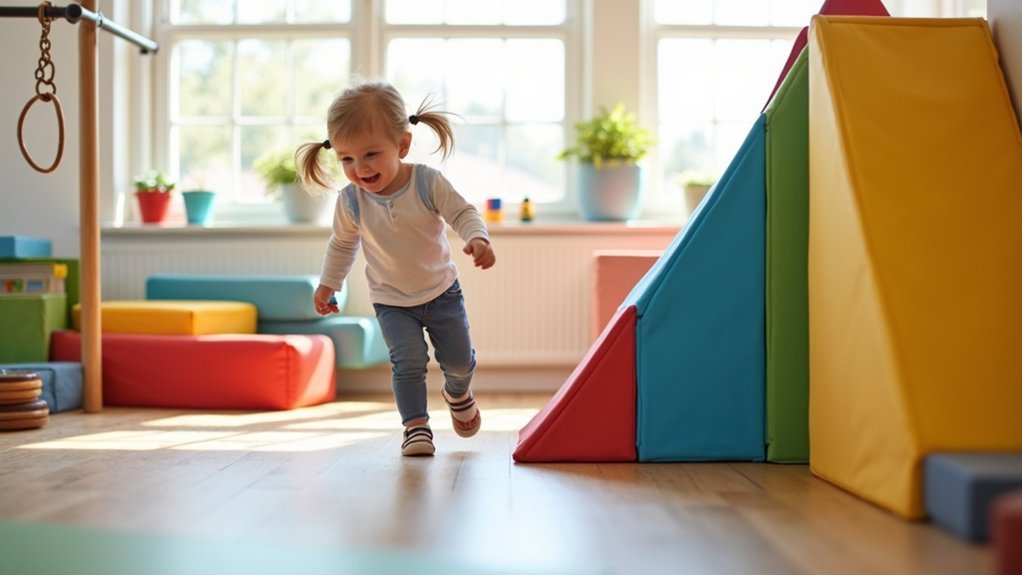
When developing motor skill strategies for children with Down syndrome, strength and coordination become foundational elements of physical development. You’ll want to focus on engaging activities that naturally improve gross motor skills and build essential physical capabilities. Utilizing playground equipment like trampolines, climbing structures, and interactive sports toys can help children with Down syndrome develop critical coordination and strength. Oversized baseball bats, rolling bowling balls, and soccer equipment provide excellent opportunities for upper body development and hand-eye coordination. Sensory play equipment further supports fine motor skills through exploratory manipulation. By incorporating diverse physical activities that are both fun and purposeful, you’ll help these children enhance their muscular strength, balance, and overall physical confidence while promoting meaningful sensory integration and motor skill progression.
Social Interaction in Adaptive Play Environments
Because social development is essential for children with Down syndrome, adaptive play environments offer transformative opportunities for meaningful interaction and skill-building. These specialized spaces cultivate social interactions through carefully designed equipment and structured activities that encourage communication skills and peer engagement.
Key benefits include:
- Group swings that promote turn-taking and cooperative play
- Sensory features stimulating shared exploratory experiences
- Collaborative games that build trust and empathy
- Inclusive playground designs supporting diverse abilities
Educators can strategically facilitate these interactions, helping children develop confidence through guided social experiences. By incorporating adaptive play environments with intentional sensory and physical components, you’ll create supportive spaces where children with Down syndrome can naturally expand their social competence, learn meaningful interaction strategies, and build lasting connections with peers.
Occupational Therapy and Play-Based Learning
Although motor skill development can be challenging for children with Down syndrome, occupational therapy (OT) offers a transformative approach through play-based learning. You’ll discover that OT strategically uses interactive activities to help children develop gross motor skills, muscle strength, and coordination. By creating a personalized sensory diet with engaging play techniques, therapists can improve overall motor function while making learning enjoyable.
Assessments help therapists customize interventions that target specific developmental milestones. You’ll find trampolines, climbing structures, and sensory-rich equipment become powerful tools for supporting children’s physical progress. These play-based strategies aren’t just about movement—they’re about building confidence, enhancing social interaction, and supporting each child’s unique developmental journey through fun, purposeful activities.
Selecting Age-Appropriate Motor Skill Development Tools
Building on the play-based learning strategies from occupational therapy, selecting motor skill development tools requires thoughtful consideration of a child’s developmental stage and individual needs. When supporting children with Down syndrome, you’ll want to choose equipment that promotes motor skill progression and engagement.
Key considerations include:
- Age-specific gross motor skill milestones
- Individual physical capabilities
- Adaptive equipment supporting independence
- Tools encouraging social interaction and communication
Strategically selected play-based equipment can transform motor skill development into an enjoyable experience. From toy kitchens that encourage standing to trampolines enhancing coordination, these tools aren’t just toys—they’re developmental catalysts. By matching equipment to your child’s unique developmental trajectory, you’ll create opportunities for meaningful physical and social growth, ensuring that motor skill acquisition becomes a dynamic, empowering journey.
Frequently Asked Questions
How to Improve Motor Skills in Down Syndrome?
You’ll enhance motor skills through engaging sensory play, coordination games, and adaptive sports that build strength. Focus on balance activities, movement exploration, and fine/gross motor exercises to support developmental progress and physical confidence.
What Tools Are Used for Down Syndrome?
You’ll need adaptive toys like trampolines, oversized balls, and sensory tables to support fine and gross motor skills. Inclusive games, balance equipment, and physical therapy tools help children with developmental challenges reach important milestones effectively.
What Are the Occupational Therapy Assessment Tools for Down Syndrome?
You’ll find key occupational therapy assessment tools like the Peabody Developmental Motor Scales, Sensory Processing Measure, and BOT-2 to evaluate your child’s fine and gross motor skills, sensory integration, and developmental milestones during early intervention.
What Is Play Therapy for Down Syndrome Children?
Play therapy helps you develop social skills, emotional regulation, and sensory integration through therapeutic games. You’ll engage in creative expression, reach developmental milestones, and strengthen family bonds while enjoying a supportive, skill-building environment.
Conclusion
You’ve discovered that play-based equipment isn’t just about fun—it’s a transformative pathway for children with Down syndrome. Aren’t adaptive play environments more than simple structures? They’re carefully designed bridges to motor skill mastery, confidence, and social connection. By selecting intentional, age-appropriate tools, you’re not just providing play equipment, but empowering developmental potential, creating spaces where physical challenges become opportunities for growth and celebration.


